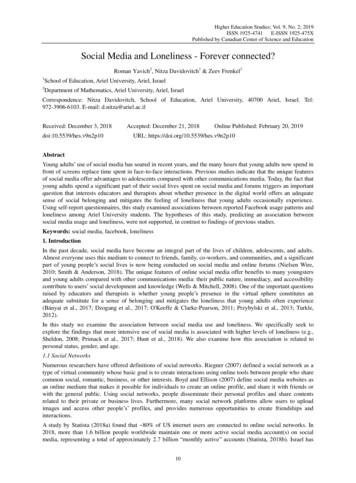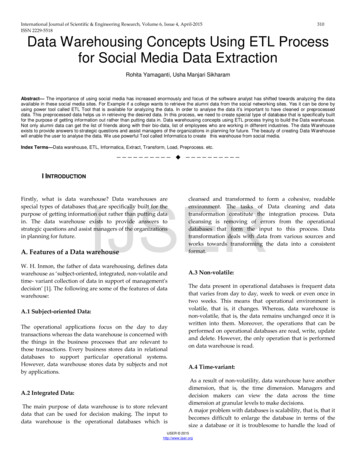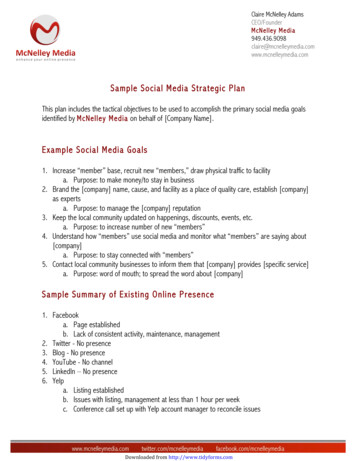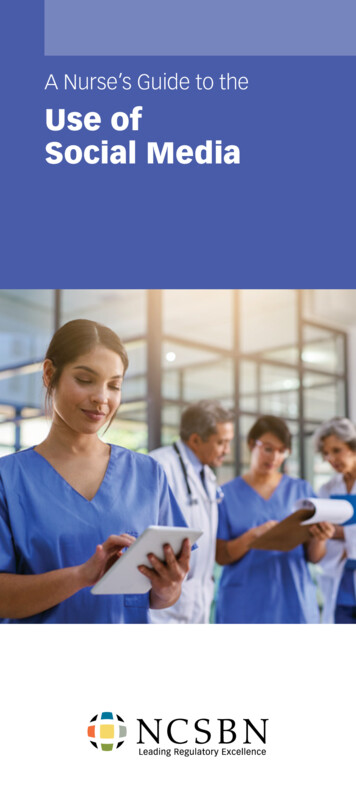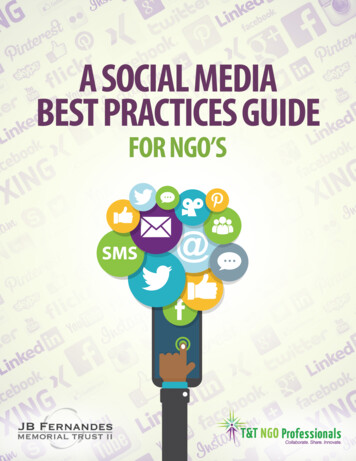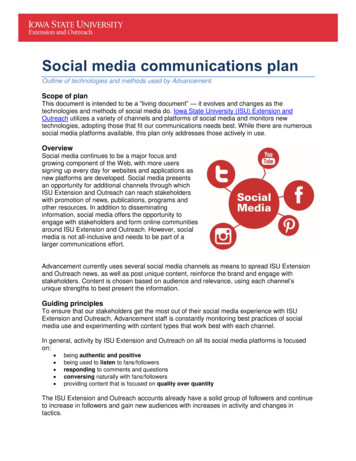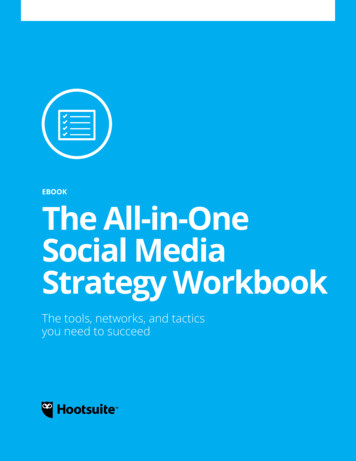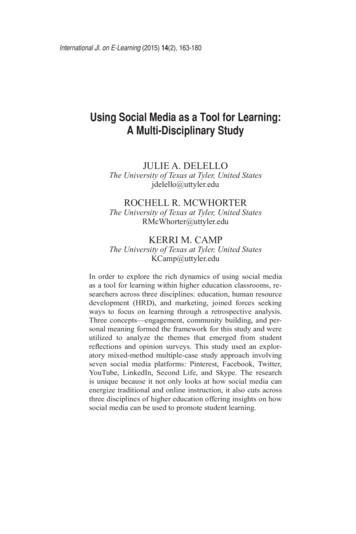
Transcription
International Jl. on E-Learning (2015) 14(2), 163-180Using Social Media as a Tool for Learning:A Multi-Disciplinary StudyJULIE A. DELELLOThe University of Texas at Tyler, United Statesjdelello@uttyler.eduROCHELL R. MCWHORTERThe University of Texas at Tyler, United StatesRMcWhorter@uttyler.eduKERRI M. CAMPThe University of Texas at Tyler, United StatesKCamp@uttyler.eduIn order to explore the rich dynamics of using social mediaas a tool for learning within higher education classrooms, researchers across three disciplines: education, human resourcedevelopment (HRD), and marketing, joined forces seekingways to focus on learning through a retrospective analysis.Three concepts—engagement, community building, and personal meaning formed the framework for this study and wereutilized to analyze the themes that emerged from studentreflections and opinion surveys. This study used an exploratory mixed-method multiple-case study approach involvingseven social media platforms: Pinterest, Facebook, Twitter,YouTube, LinkedIn, Second Life, and Skype. The researchis unique because it not only looks at how social media canenergize traditional and online instruction, it also cuts acrossthree disciplines of higher education offering insights on howsocial media can be used to promote student learning.
164Delello, McWhorter, and CampUSING SOCIAL MEDIA AS A TOOL FOR LEARNINGWhen the U.S. Department of Education (USDE) released its NationalEducation Technology Plan, Transforming American Education: LearningPowered by Technology (ED, 2010), it charged institutions involved in preparing educators to provide technology-supported learning experiences thatpromote and enable the use of technology to improve learning, assessment,and instructional practices. The plan encouraged educators to “leverage thelearning sciences and modern technology to create engaging, relevant, andpersonalized learning experiences for all learners that mirror students’ dailylives and the reality of their futures” (p. 4). President Barack Obama calledfor educators to support innovative approaches to teaching and learning, tobring lasting change to our lowest-performing schools, and to investigateand evaluate what works and what can work better in America’s schools.To meet the extensiveness of these responsibilities in order to change thecurrent landscape of our educational institutions is a daunting task for anyeducator. Schools must find ways to meet the needs of our students, in aglobally, connected world. Perhaps, we must consider a new investment-one that will improve teaching and learning in all content areas usinginnovative methods in technology. One such innovative technology, theuse of social media, may be the golden ticket to provide students withmeaningful, connected learning experiences.However, there islimited research on using social network sites which specifically impactstudents and address learning (Chen & Bryer, 2012; Kumar & Vigil,2011; Roblyer, McDaniel, Webb, Herman & Witty, 2010).Greenhow (2008) ad-mits that the current literature consists of mainly“speculative, anecdotal, and opinion pieces or studies that focus onpopulations other than K-16 stu-dents and teachers” (p. 191).REVIEW OF THE LITERATURESocial Media Trends in EducationSocial media are Web 2.0 technologies that facilitate social interactionand collaboration, and foster a sense of community (Bingham & Conner,2010). Experian (2012) ranks the top six social network sites by total visits as: Facebook (7 billion), Twitter (182 million), Pinterest (104 million),LinkedIn (86 million), Tagged (72 million), and Google (61 million).These social networking websites have become a significant part of U.S.college students’ lives (Junco, Heiberger, & Loken, 2010).Yet, although many educators embrace social media on a personal level,concerns still exist when using it for classroom instruction. In a U.S.study completed in 2011, Pearson Learning Solutions and the Babson
Using Social Media165Survey Research Group collected data from 1,920 faculty members, highlighting the fact that “virtually all higher education teaching faculty areaware of the major social media sites over 90% of all faculty are usingsocial media in courses they’re teaching” (Moran, Seaman, & Tinti-Kane,p. 3). However, the use of social media seems to be limited in nature to primarily online videos (61%) as compared to other social media sites such asFacebook (4%) or Twitter (2%). More importantly, the instructors who reported using this social technology in the classroom restricted it to instructor posts rather than student-created content. Other prominent concernsseemed to dominate the results including the time it took to integrate themedia into courses and concerns with issues regarding both privacy and integrity. When faculty members across the United States were surveyed onthe use of social networks as a course strategy, the results revealed that although instructors were familiar with technology, most utilized discussionsand blogs within a content management system (CMS) (Chen & Bryer,2012; Dunlap & Lowenthal, 2009) instead of utilizing popular social mediasites.Kumar and Vigil (2011) reported that students look to faculty to useand model new technologies. However, the use of discussion forums werefound to be the only tools that pre-service teachers used more for educational purposes (77%) than for informal purposes (53%). Faculty may not havethe specific strategies on how to assess the use of social media believingthat social networking should be used primarily for informal activities(Chen & Bryer, 2012) or that technology is more about the teacher thanthe student (Kumar & Vigil, 2011). In order for a teacher to find creativeways to use technology in the classroom, they must first find value in thetechnology it-self, moving from “what social media is” to strategies on“how to use it”. “Traditionally, students come to school ‘powered-up’and wired with the newest technologies available—but often they mustleave them at the door, since faculty do not use them in classrooms and mayeven regard them with suspicion” (Roblyer, et al., 2010, p. 134).Obviously a disconnect exists between teaching and learning—a gapin technology understanding that “prevents technology from being used inways that would improve instructional practices and learning outcomes”(ED, 2010, p. 10).Engaging, Connecting, and Meaningful Learning with Social MediaA shift is occurring in education whereby the learning environment is becoming decentralized moving from instructor and institution to one wherestudents direct their own learning, find their own information, and createknowledge by engaging in networks away from the formal setting (Kop &Hill, 2011) that is ripe for social media learning. When examining the literature, however, few relevant examples of how social networks are being
166Delello, McWhorter, and Campintegrated into academia are found; however, the following studies suggestthat today’s social technologies hold the potential for transforming teachingand learning.Twitter (www.twitter.com) has been used as a pedagogical tool in bothundergraduate and graduate courses. Junco, et al. (2010) utilized the National Survey of Student Engagement (NSSE) to study the effect that Twitter had on student engagement and grades. Twitter was found to not onlyincrease college students’ engagement and improved grades but it also increased interaction with peers and instructors for deeper interpersonal connections. Similarly, Dunlap, et al. (2009) found that using Twitter in classroom environments allowed student interactions to be natural and immediate, enabled social presence, continued conversations after the semester, andallowed for the construction of meaning through communication.Rinaldo, Tapp, and Laverie (2011) described using Twitter in a consumerbehavior course to “follow” the professor. Students were surveyed to assesstheir opinions regarding its role in career preparation, traditional educationgoals, and the use of classroom time. In this study, both the professor andthe students were relatively inexperienced with Twitter, so their perceptionsincreased positively throughout the semester. Students reported that Twitterhelped them understand and learn course material and achieve competencyin the subject matter, and the students believed that knowledge of Twitterwould assist in finding future employment.Researchers at Harvard University created an online forum using theplatform Ning (http://www.ning.com/) with their pre-service teachers in anattempt to create a “community of praxis”, for increasing both student engagement and learning. Ning is a social network similar to Facebook whereusers create or join particular networks with others who share similar interests. The researchers recognized that both pre-service and professional educators struggle to find time to read, plan, or reflect on good teaching practices due in part to isolation in the teaching area, confinement to a singleschool or mentor, and the demands of the profession. By creating a Ningnetwork, the hopes were to build a community of learners. Although theresults indicated that the pre-service students felt that instructors underemphasized the relevance of the activity, students were engaged in meaningful conversations which reinforced learning (Reich, Levinson, & Johnston,2011).“Students’ use of blogs, wikis, and social bookmarking has been of particular interest to educators who perceive these technologies as beneficialin higher education” (Kumar & Vigil, 2011, p. 145). For example, Wells(2007) introduced pre-service teachers to wikis, blogs, and podcasts. Thestudents were required to read about the new technologies, engage withthese new technologies as part of an assignment, and demonstrate their
Using Social Media167knowledge and understanding of the content unit by presenting it in a wiki,a blog, or podcast that they created. The research revealed that many of thestudents not only combined these new technologies but also included otherWeb 2.0 tools that had not been introduced in class. According to Wells,“Once they [students] became interested many really flew with the idea.Even those who felt less than confident commented later that they had learntso much from the experience that they felt much more confident to try themout during future teaching placements” (p. 5).Other studies have shown that social media not only increased interestand engagement but also creativity. Grounded in social constructivistism,Perry, Dalton, and Edwards (2009) considered whether the use of thoughtprovoking images in conjunction with course reflections would generateengagement, social connections, and enhance the learning environmentfor students taking online courses. The researchers integrated the Web 2.0technology PhotoVoice (PhotoVoice.org) into their course. PhotoVoice isan online social media for participatory photography, digital storytelling,and self-advocacy projects. The findings revealed that by integrating photography and digital storytelling methods with in-depth course reflections,instructors increased interest, engagement, personal meaning, and creativeness with their students. Using this new technology, relationships werefostered, ideas were shared, and social connectedness was formed betweenclassmates as well as with instructors. While the findings supported innovative teaching strategies, the study encouraged instructors to develop and implement effective teaching strategies that created communities and maximizelearning within the community context (Perry, et al., 2009).One of the advantages of social media in the classroom from a marketing perspective is its potential for viral marketing, meaning the voluntarysharing of information among users. For example, YouTube (http://www.youtube.com) provides an opportunity for student-generated media and viraladvertising. One study of MBA marketing students required the creation ofan Internet “spoof” video posted on YouTube with the objective of maximizing the number of video views (Payne, et al., 2011). Most students expressed enjoyment in creating the advertisement based upon entertainment,creativity, teamwork, and challenge.From tweets to visual stories, the type of social media used in the abovestudies share a ubiquitous thread—(1) a sense of community building, (2)engaging students in the learning process, and (3) students forming a personal meaning for the material learned. These three concepts formed theconceptual framework for this study and were utilized to inform researchquestions and analyze the themes that emerged from the data collected inthe study (Maxwell, 2012).
Delello, McWhorter, and Camp168Importance of the StudyThere is limited research focused on social media for pedagogical use inthe higher education classroom. Thus, this study explores how social mediapromotes learning in the college classroom by facilitating student engagement, community building, and personal meaning. To this end, college student reflections were collected across three disciplines that utilized socialmedia for learning. These reflective data may serve useful for future studiesand suggest important avenues necessitating further research.METHODOLOGYContextIn order to explore the rich dynamics of using social media as a tool forlearning within higher education classrooms, researchers across three disciplines: education, human resource development (HRD), and marketing,joined forces seeking ways to focus on learning through a reflection of practice. This research project sought to answer the following research questions:1) How did social media create a sense of engagement?2) How did social media facilitate a sense of community?3) What personal meaning was facilitated through social mediatechnology?Research Design and Data CollectionThis exploratory mixed-methods research used a multiple-case study approach (Bryman & Bell, 2007) to examine seven social media platforms:Pinterest, Facebook, Twitter, YouTube, LinkedIn, Second Life, and Skypefor the purpose of classroom learning. Two of the three cases involved datacollected from retrospective student reflections on the use of social mediain the classroom following learning activities (Education and HRD). Thethird case (Marketing) utilized qualitative and quantitative data collectedfrom voluntary opinion surveys and reflective comments to examine studentperceptions regarding the social media project. Although data was originallycollected for academic purposes during the 2011-2012 school year, Institutional Review Board (IRB) approval to use students’ reflections as retrospective data was subsequently obtained. Each social media learning activity is briefly defined below to give a context for how the tool was utilized tofacilitate student learning.
Using Social Media169Case One: EducationImagine learning to teach when you have never been in a classroom.Imagine being asked to design lesson plans based upon ideas that you havenever experienced or to create a classroom management plan for studentsyou have not seen. For many pre-service education students, this is theirreality. For that reason, Pinterest (Pinterest.com) was selected as the socialmedia platform for pre-service students to explore new ideas in teachingand classroom management and gather these ideas collectively through theuse of images.Created in 2009 and launched in March of 2010, Pinterest is a new classof social tools (Experian, 2012) where users can visually share, curate, anddiscover new interests by pinning images to an online pinboard. With overa hundred million visitors per month (Go-Gulf, 2012), current trends showPinterest to be one of the top three network sites in the United States (Experian, 2012). According to the site, the goal of the social media platform is“to connect everyone in the world through the ‘things’ they find interesting”(Pinterest, 2012a).Figure 1. Student pinboard on Pinterest. Source: Teach for Kids, Pinterest(2012b). Retrieved from http://pinterest.com/teachforkids/.
170Delello, McWhorter, and CampPinterest was integrated into both a classroom management course anda PK-6th grade teaching skills course as a novel type of instruction andstudent reflections were collected through an online forum within the content management system Blackboard. For this project, a Pinterest groupwas created for the course. Once the account was set up, the group profilewas edited, creating a display name, profile picture, and description of thepurpose of the site (see Figure 1). Students enrolled in the courses weregiven the user name and password specific to the course. In order to create a meaningful assignment and build a community of praxis, studentswere required to choose a minimum of ten resources from the web that theyplanned to reconstruct or utilize in their own classrooms after graduation.These ten items could either be pinned onto one of the existing boards orthe students could construct new categories leaving feedback on each posting for others to read as to why they believed the pin would be valuable tothem as a teacher.In addition, students were asked to 1) reflect upon the pins they choseto post, 2) explain what they learned from using the social platform, and3) discuss whether they would use the site in the future. Students were encouraged to create their own Pinterest site to pin ideas from their colleaguesand to save their own pins so that after the course was completed theywould have a site created from their own personal interests and needs.Case Two: HRDHuman Resource Development (HRD) is a discipline with the primarypurpose of strategically improving an organization to make it more effective (Gilley & Gilley, 2003). This effectiveness is achieved through variousinitiatives such as employee training and development, career development,organization development, and numerous learning-based programs (Chalofsky, 2011). As in other fields, technology is having an enormous impacton the field of HRD (McWhorter, 2010) and a new area of inquiry, Virtual HRD, has now emerged that embraces sophisticated technologies in theworkplace for increasing learning capacity and performance (McWhorter &Lindhjem, 2012).Social media data utilized in the HRD classroom collected for the current study included 151 participants. Data was collected from: a) 53 studentreflections on the use of Skype and Second Life in an online master’s levelclass on leadership and ethics, b) 44 student reflections on the use of SecondLife for a training activity in an online master’s level class on workforcedevelopment; and, c) 54 student reflections on the use of LinkedIn for professional networking in a hybrid undergraduate capstone experience class.Skype (http://www.skype.com) is a video conferencing program that facilitates real-time interaction over the Internet. This platform allows for text
Using Social Media171chat, voice chat, video chat, and sharing of screens for presentations or Internet tours. In the current study, student reflections of synchronous realtime group meetings (RTGMs) held every three weeks in an online master’sclass were collected and examined. Each group of approximately five students was required to hold four RTGMs during the semester that discussedthe topic of the week and formulation of a group ethics project.Second Life (http://secondlife.com) is a 3D virtual world where a number of universities hold online classes and professional meetings through theuse of an avatar, or graphic representation of the user (Mancuso, Chlup, &McWhorter, 2010). This environment has been found to be useful for students to interact synchronously (in real-time) due to its use of text and voicechat capabilities which establish virtual presence (Burgess, Slate, RojasLeBouel, & LaPrarie, 2009). In the current study, student reflections weregathered following RTGMs and a one-hour training session.LinkedIn (http://www.linkedin.com) is the largest professional networkon the Internet with over 160 million members in 200 countries (LinkedIn.com, 2012). Its users collaborate through private messaging or group discussions and by public status reports similar to Facebook. Also, users canpost their online resume, work history, education, and listing of skills andabilities as well as integrating with Twitter, Slideshare.net, and many othersocial media sites. In the current study, 54 undergraduate students (seniors)in two capstone experience hybrid classes utilized LinkedIn for creatingtheir professional network to showcase their skills, and connect to classmates, university professionals, and area and regional contacts. Additionally, students joined professional groups and generated a web link to theironline profile for their resume and cover letter constructed in the course.Case Three: MarketingContemporary businesses struggle with how to use social media tools effectively. Because of this, college recruitment increasingly focuses on marketing students who have expertise managing and administering social networks, not merely from a personal usage experience, but those who understand the complexities of social media marketing from a business perspective. One study noted: “Managers have struggled to deal with the challenges that consumer-generated advertising and viral marketing pose” (Payne, etal., 2012, p. 204). To ensure that marketing students possessed these criticalskills, Facebook, Twitter, and YouTube were utilized for an analysis projectin an undergraduate marketing course.According to Experian (2012), more than 50% of online adults usedFacebook regularly; the network is positioned to be a unique source of value to marketers (p. 87). Facebook’s mission is “to give people the powerto share and make the world more open and connected” (Facebook, 2012).
172Delello, McWhorter, and CampTwitter is a real-time information network that connects individuals to thelatest stories, ideas, opinions, and news through 140 character tweets (Twitter, n.p.). YouTube is the world’s top video sharing site with over 800 million unique users each month (YouTube, 2012).The objective of the classroom project was to identify social media strategies utilized by top retail companies by answering the question: “How areretailers using social media to interact with customers?” Fifty retail companies were selected from the top fifty companies listed on Stores 2011 Top100 Retailers (NRF Stores, 2012) and then grouped by store format (grocery, discount, restaurants, department, etc.). Students self-selected into 13groups and determined which group of stores to analyze. The integrated assignment required students to conduct a content analysis including developing tables with the following information: social media location (Facebook,Twitter, YouTube), content of most recent 50 posts (information, questions,suggestions, complaints, etc.), time period of most recent 50 posts (numberof days/weeks/months/years), positive or negative nature of posts, and thesource of the post (company or consumer).The marketing project also included comparison of the retailers’ socialmedia strategies including an analysis of the effectiveness of those strategies. Findings were presented in a formal business report and oral presentation. A voluntary opinion survey regarding the social media project wascompleted by students at the conclusion of the project. Forty-eight studentswere enrolled and participated in the social media analysis project and 25students completed the survey which included nine Likert questions and oneopen-ended question.ANALYSIS OF THE DATAThe first step in the analysis process involved exploring the data and thenorganizing it into a usable format. Transcripts were created from writtenstudent reflections, then arranged, numbered, and coded for content. Thedata was organized, as Bogdan and Biklen (1992) proposed, by breakingthe information down into “manageable units, synthesizing, searching forpatterns, discovering what is important, what is to be learned, and deciding what to tell others” (p. 157). The researchers looked for themes emerging from the data and then created conceptual categories in which to formthe framework for the analysis. Merriam (1998) pointed out the categoriesshould “reflect the purposes of the research and in effect are the answers tothe research questions” (p.183). Prior to coding, the researchers reviewedtheir conceptual framework constructed at the onset of their study.
Using Social Media173After collecting and transcribing all of the qualitative data individually,the research team then triangulated the study’s validity and reliability byutilizing multiple sources of data (three separate disciplines) and sorted thedata using the conceptual framework which served as a heuristic for organizing and reporting the data most relevant to the study. Furthermore, theteam compared their interpretations across disciplines looking for distinctpat-terns. Because of the vast number of reflections collected in this study,only a few excerpts were documented in this paper.RESULTSAnalysis results are discussed below according to the three researchquestions in the study. Based upon the students’ reflections, a matrix wasdeveloped to aid in conceptualizing the social dimensions of engagement,community, and personal meaning in terms of instruction and learning. Table 1 provides a visual depiction of the relationship between the conceptualthemes and student reflections of using social media.ENGAGEMENTThe following question was considered and reflections were analyzed inorder to determine, "How did social media create a sense ofengagement" [for the students in this study]?As revealed in Table 1, excerpts from the students confirmed that the use ofsocial media in the classroom was engaging and fun. For example, students who initially thought the Pinterest assignment was too consuming oftheir time changed their minds: “At first I thought ten items was too manyitems to find and pin, but once I started checking out the different categoriesand fun activities, I realized ten things to pin was not enough” (P005, 2012,p. 3). Another student echoed the sentiment: “When I first got on Pinterest, Ihad one education board and now I have more than 20” (P040, 2012, p.10).Students demonstrated that using social networks increased both motivation and enthusiasm for learning declaring: “I love using this Website; itopens up a whole world of creativity to be explored” (P044, 2012, p.10). Infact, another student exclaimed: “This was the best homework assignment Iever got!” (P001, 2012, p.1). Interestingly, none of the students reportedboredom with the Pinterest assignment and marketing students thought theworkload was reasonable (84%).Likewise, HRD students were very interested in the social media LinkedIn. One student remarked: “I learned firsthand the v alue o f u sing various tools like LinkedIn to increase my visibility to employers” (P228, 2011,p. 4). Another said: “Creating a LinkedIn account helped me realize thatbusinesses can see me as a professional, rather than just a profile on a socialmedia website” (P230, 2011, p. 4).
Delello, McWhorter, and Camp174Table 1Examples of Student Reflections Based Upon Conceptual ThemesSocialMediaCommon ThemesEngagementPinterestFacebook,Twitter, andYouTubeSkype,LinkedIn, andSecond LifeCommunityPersonal Meaning"I have become addicted.I love this website" (P005,2012, p.1)."I learned from this lesson thatthere are many ideas out there,and it is great that people sharetheir ideas with other educators"(P002, 2012, p.1).“This was a great way to build myclassroom ahead of time” (P066,2012, p.14)."I am so fortunate to have you(Pinterest) in my life. We aregoing to swap ideas for manyyears to come!” (P045, 2012,p.11)."With you searching what youcan, your friend doing what theycan, and people who share yourinterests searching--everyonecan conquer more" (P016,2012, p.5).“I used a lot of the pins to help withmy lesson plans for student teaching,so it was a blessing!" (P014, 2012,p.4).“I find it all so useful and fun!"(P011, 2012, p.4)."I can find teaching ideas thathave been used across theworld" (P012, 2012, p.4)."If you are not activelylistening and engaging yourcustomers, in about a day thenyou will lose their attention"(P137, 2012, p. 1)."Having a group to work withhelped me learn more andbounce ideas off each other"(P125, 2012, p.1)."I think it was a good project" (P120,2012, p. 1)."Social media is going tobecome a company's greatestcommunication to its customers" (P126, 2012, p. 4)."I disagree it should be anindividual assignment becauseyou can't compare" (P114,2012, p.1)."Useful project" (P122, 2012, p.1).“Skype is a great classroomfor online learners” (P203,2012, p. 2).“I enjoyed the group interactionwith my peers on Skype. It wasvery helpful to be able to seeand communicate with others(P205, 2012, p. 2).“In a virtual world [Second Life] youcan get an almost-hands-on type ofexperience without the safety risk thatreal world instruction [in laboratories]might include” (P211, 2011, p. 3).“I was more active in payingattention and participatingin questions being asked. Ibelieve Second Life is usefulbecause it is more like real life”(P212, 2011, p. 3).“I created a profile onLinkedIn I invited friends,made new contacts joinedseveral professional groups”(P259, 2011, p. 7)“Students are able to get ‘hands on’experience without ever being in realdanger. They are able to learn safetymeasures first in a safe environment”(P216, 2011, p. 3).“Second Life was a fun andgreat way to meet in a groupsetting without being in person.The option to chat and speakkept the meeting going at asteady pace” (P204, p. 2).“I love Second Life it is awonderful learning tool andthink it should be used moreoften in online classes. Thedown fall of many online classesis the lack of connection” (P207,2012, p. 1).“Good way of training” (P220, 2011,p. 3)."It was much more relevan
164. Delello, McWhorter, and Camp USING SOCIAL MEDIA AS A TOOL FOR LEARNING When the U.S. Department of Education (USDE) released its National Education Technology Plan, Transforming American Education: Learning Powered by Technology (ED, 2010), it charged institutions involved in pre- pa



